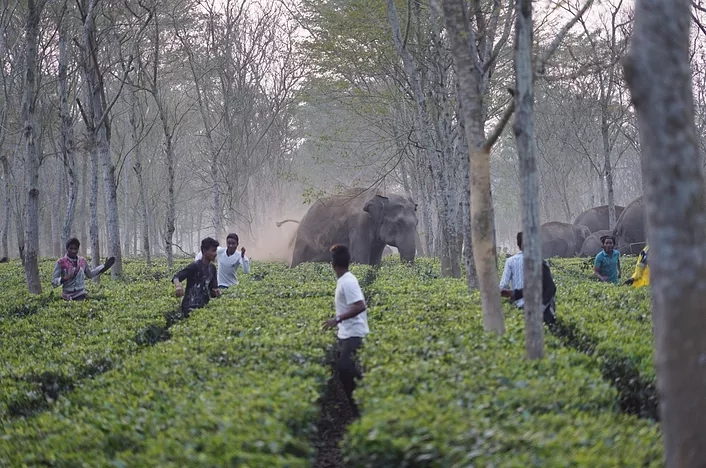Love thy neighbor: Can humans and animals live next to each other in peace
Anish Paul
 A leopard wandering in a tea estate. Image by- Aritra Kshettry.
A leopard wandering in a tea estate. Image by- Aritra Kshettry.
People have been sharing spaces with large mammals like elephants and leopards for eternity in northern West Bengal. But over the last few decades, this region has been reporting one of the highest human-wildlife negative interactions globally. A group of scientists are trying to find how the coexistence of human and wildlife can be promoted in this pristine yet modified landscape.
Tweet
Elephants and leopards can live and roam around in human-use lands without promoting negative interaction. Even though this might sound fictional, a study published in the journal “Global Ecology and Conservation” in January, 2020 argues that this might be the key to secure the future of these animals in northern West Bengal.
The paper, authored by Aritra Kshettry and collaborators, urges us to look beyond the protected areas and curate a pathway for promoting safer shared spaces among human and wildlife.
 Credits: Aritra Kshettry
Credits: Aritra Kshettry
“Persistence of large threatened mammals is rarely investigated outside protected areas”, said Kshettry, a DST-INSPIRE fellow studying leopards and elephants in the tea estate dominated forest-agricultural landscape mosaic in West Bengal for his doctoral studies. “All the conservation focus is restricted to forested areas only”, he opined.
In India, there are hardly a few patches of “pristine wilderness” left for wild animals and only 5% of the total land is designated as protected areas. Hence, it is impossible to conserve India’s extravagant wildlife inside the wild only. “Wildlife does not understand our man-made protected area borders”, remarked Vidya Athreya, a Scientist at Wildlife Conservation Society-India and a co-author of the study.
The study area, tea-plantation dominated human-use landscape of West Bengal, records one of the highest instances of human casualties by leopards and elephants worldwide. This naturally stirs a sense of fear and stigma related to these animals among the locals. Human deaths and economic loss often leads to retaliatory killing and hampers conservation activities.
The study deals with both ecological and social parameters of human-wildlife interactions to understand how ‘conservation beyond boundaries’ can be promoted in this land of conflict. They surveyed around 1200 km² of non-forested areas consisting of tea-estates, agricultural land, and human settlements to understand how leopards and elephants make use of it. Leopards have been found to be a ubiquitous resident of the dense tea plantations, and they use them as breeding grounds as well. No leopard presence has been observed in agricultural lands. Elephants, in contrast, use plantations, agricultural lands and human habitations as corridors to move from one forest patch to another.
Their study also conveys how local stakeholders of different socio-economic levels can contribute to tackle human-wildlife negative interactions. The authors reviewed the existing literature from the land. They merged it with their five-year long experience in the area. Together, it revealed the potential role of each existing stakeholder to curtail the negative impacts of human-wildlife coexistence. Results show that district and tea-estate administrations have the most influential role in minimizing the negative interactions. Actions like installation of solar fencing, lights, early alarm systems etc., production of loud sound before the commencement of work and prohibition of illegal alcohol brewing, if taken by these two authorities, can positively impact human-wildlife encounters.
 The native vegetation of Dooars is represented by a matrix of Sal-dominated moist tropical lowland forests along with patches of riverine grasslands
The native vegetation of Dooars is represented by a matrix of Sal-dominated moist tropical lowland forests along with patches of riverine grasslands
The paper aims to promote the idea of identifying conservation-compatible landscapes outside protected areas by addressing the persistent scenarios of conflict and coexistence present in the study area. “Development of conservation strategies to ensure long term persistence of these species in such habitats and mitigation of current and future conservation conflicts,” replied Kshettry when asked about future steps.
The study, according to Kshettry, “may be applicable to other tea-plantation dominated landscapes where leopards and elephants are present, especially fragmented forest-tea mosaics of Assam, Sri Lanka and Nilgiris.” Dr. Athreya opined that this study can promote coexistence everywhere in the country where human and wildlife share space.
This study aims to serve both the ecological needs of wildlife and the socio-economic needs of locals. It can be considered as a framework to foster long term human-wildlife coexistence in areas with high human density.
 Tea workers plucking tea leaves in a tea estate of Dooars
Tea workers plucking tea leaves in a tea estate of Dooars
References
Anish Paul is a student of MSc Ecology at the Pondicherry University. He is interested in singing, writing and travelling and wants to study the ecology, behaviour and conservation of mammals to make a living
Note: This article was submitted by Anish Paul as an assignment during the workshop Scicomm for Scientists 2021, organised by Cogito137, IISER Kolkata, funded by the Department of Science and Technology, Govt. of India. The assignment was selected for publication and has undergone due editorial process. Team Cogito137 thanks Spoorthy Raman for the initial editorial review of this article.
signup with your email to get the latest articles instantly